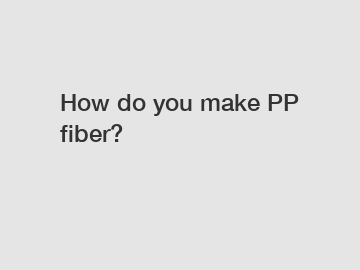Dec. 12, 2023
Chemicals
If you want to learn more, please visit our website AiBeiDe.
How Do You Make PP Fiber?
Polypropylene (PP) fiber is a type of synthetic fiber known for its durability and versatility. It is commonly used in various industries such as textiles, geotextiles, and concrete reinforcement. PP fiber is manufactured through a complex process that involves several stages. In this article, we will unveil the step-by-step process of how PP fiber is made.

Raw Material Selection.
The first step in making PP fiber is selecting the right raw material. Polypropylene resin, which is a thermoplastic polymer, serves as the main ingredient. It is chosen for its unique properties such as high tensile strength, resistance to chemicals and heat, and low density. The quality and purity of the resin significantly impact the final product's performance.
Melting and Extrusion.
Once the raw material is selected, it undergoes a melting and extrusion process. The PP resin is melted at high temperatures, typically around 180 to 230 degrees Celsius. This molten resin is then extruded through spinnerets, which are small holes with precise diameters. The extrusion process is responsible for creating the distinctive shape and size of the PP fibers.
Cooling and Solidification.
As the molten resin emerges from the spinnerets, it immediately comes into contact with cool air or water. This rapid cooling process solidifies the molten resin, transforming it into solid PP fibers. The cooling method can vary depending on the desired characteristics of the fibers. Air cooling promotes a higher level of orientation, while water cooling enhances the fiber's cooling rate.
Drawing and Orientation.
Suggested reading:The solidified PP fibers undergo a drawing and orientation process to enhance their strength and elasticity. Drawing involves stretching the fibers to align the polymer molecules in the direction of the fiber's length. This orientation ensures the fibers possess high tensile strength. Different drawing techniques such as wet and dry drawing are utilized based on the desired fiber properties.
Crimping.
To improve the fiber's bulkiness, crimping is applied. Crimp is a wave-like pattern introduced into the fibers, giving them a three-dimensional structure. This process allows the fibers to interlock, creating excellent cohesion when used in various applications. Crimping can be done mechanically or through heat, depending on the desired crimp level and fiber characteristics.
Cutting and Collecting.
After the crimping process, the continuous PP fibers are cut into desired lengths. This step provides flexibility in choosing fiber lengths suitable for specific applications. The cut fibers are then collected and baled for further processing or direct use. Quality control procedures ensure that only fibers meeting the required standards are packaged and distributed.
Conclusion.
Polypropylene (PP) fiber is a remarkable synthetic fiber with outstanding properties, making it a popular choice in several industries. The process of making PP fiber involves raw material selection, melting, extrusion, cooling, drawing, crimping, cutting, and collecting. Each step is crucial in determining the final quality and characteristics of the fiber.
If you have any further questions about PP fiber or would like to explore its applications, please do not hesitate to contact us. We are happy to provide you with more information and assist you with your specific needs.
Keywords: Contact us.
If you are looking for more details, kindly visit our website.
If you are looking for more details, kindly visit hpmc manufacturer.
Suggested reading:Related Articles
If you are interested in sending in a Guest Blogger Submission,welcome to write for us!
All Comments ( 0 )